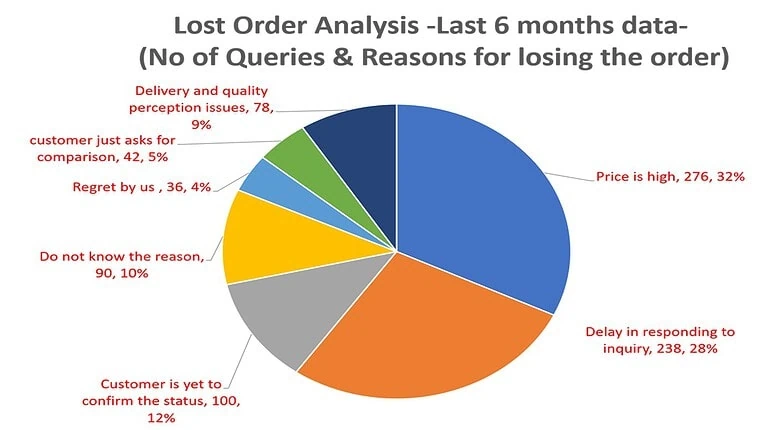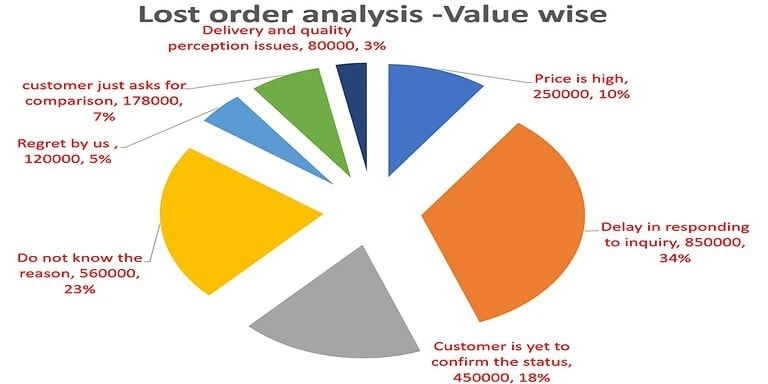Article Contents:
One challenge many small business promoters face is acquiring sales leads and converting inquiries into orders.
At one of my client organizations, the conversion ratio was 0.75% despite receiving numerous leads and inquiries through digital initiatives, branding, and other marketing efforts.
Why do we struggle to convert the inquiries into sales orders?
Can we get some insights from the past data on inquiry?
Lost order analysis is a robust process that provides insight into your organization’s capability to convert queries into sales orders.
Conducting a structured analysis of lost orders will help you identify insights into lost inquiries and develop strategies to improve the conversion ratio. This article will explore Lost Order Analysis and proven practices for improving conversion ratio and customer experience using real examples from small businesses.
What is Lost Order Analysis?
Lost Order Analysis is a retrospective examination of why a business fails to secure potential customer orders.
This analysis helps identify and understand the factors contributing to losing an order, providing valuable insights for improving future performance.
While inherently reactive, Lost Order Analysis is crucial in refining strategies, processes, and interactions to enhance the likelihood of winning future orders.
For example, given below the pictorial view of lost order analysis of last 6 months data and classified the losses in many categories like
- Price is high
- Delay in responding to inquiry
- customer is yet to confirm
- do not know the reason
- Regret by us
- Customer just asks for comparison
- Delivery and Quality perception issues
In each category, no of incidents and percentage on overall incidents are given.
This type of data collection and analysis will give first hand information on why the organization loses the order.
The data can be sourced from CRM software used within your organization or compiled from your sales inquiry data. The frequency of data compilation can be quarterly, biannually, or even monthly, and this depends on the organization’s size and the volume of queries it handles at any given time.

If you want to know the lost order in terms of VALUE, you can classify the data into VALUE, as shown below.
The combination of “No of Queries” and ” Values” will help the team better understand the need for lost order analysis, which will bring a sense of urgency to the team.

Focus on Insights than data
Once you have data and analysis, you will be able to identify patterns.
For example, based on the analysis, the data demonstrates that the highest number of lost orders is attributed to delays in responding to queries, which affects both the “Number of Queries” and “Value”.
This provides insight into your organization’s agility and the team’s response speed to queries.
Can anything be done to improve response speed?
One solution could be to simplify the Cost Estimation process, facilitate collaboration between the technical and commercial teams by colocating them, and simplify the pricing approval process, among other things.
Analyzing the lost orders will offer valuable insights into your organizational structure, pricing process, and team empowerment, ultimately helping to minimize future opportunity losses.
Case study example of lost order analysis impact
In one of my client’s organizations, when we initiated the sales lost order analysis, the team found that “PRICE” was the major contributor to lost orders in all quarters. It’s common for “price” to be a significant factor in losing orders for many organizations. However, we didn’t stop there. We further analyzed each query categorized as a pricing issue in terms of the percentage difference the team lost to competitors: 5-10%, 10-15%, 15-20%, and more than 25%.
The analysis revealed a new insight: The organization was losing the order due to a price difference of 10-15%. Upon further examination of the cost structure, including raw material costs, manufacturing costs, and other expenses, our team discovered that some cost elements were based on rough estimates, and some expenses were duplicated, such as “LOT size” expenses. Additionally, depreciation was factored into each pricing, but it could be considered discretionary.
When we substituted the actual expenses for all the values, the team realized that they could have easily won the order instead of overquoting and losing it.
After improving the cost estimation process, the team automated it using TALLY software to update the costing sheet with the latest expenses. This initiative helped the organization win an order and significantly increased the conversion ratio.
Frequency - Lost Order Analysis
How frequently should we do lost order analysis?
It depends on many factors, such as how many queries you handle monthly. If you handle more queries in a month, you spend more time on quote preparation, and you should see the impact in the form of confirmed orders. If your conversion ratio is meager, you can conduct a lost order analysis every month. However, you should also consider your industry or customer response time to queries.
For example, in some industries, the development lead time is six months. In those cases, you have to wait for a reasonable period to get a response from your customer, which would also be around six months.
So, it depends on the industry or customer you serve and the number of queries you handle in a given period.
In my experience, considering the bandwidth and size of queries that most small businesses handle, I suggest conducting the lost order analysis once a quarter. That will provide sufficient data along with reasons.
Role of business head in lost order analysis
Even though most of us believe that losing the order is something the sales function should be concerned about. In reality, losing the order is primarily due to the organizational agile mindset, the attitude of a cross-functional team, the pricing process, and empowerment issues.
Hence, the business head is significant in bringing the team together on lost order analysis and driving initiatives to increase the conversion ratio.
The business head can steer the following initiative to improve the conversion ratio.
- Encourage the team to do the lost order analysis periodically, say every quarter, and review the causes along with the cross-functional team, as this helps the team introspect the causes.
- Create a techno commercial team to respond quickly to queries instead of working sequentially.
- The cost estimation process can be streamlined with a simple template and guidelines, which will eliminate the delay in getting approval.
- Focus on improving the organization’s delivery capability, as this will improve the customer’s perception of the organization.
- At times, a quote can only be provided after the approval of prototype samples. In such cases, delays can occur due to the readiness of the prototype samples. The business head can offer support to streamline the sample submission process to customers, which can improve customer perception.
Summary
Lost order analysis is not a sale functional activity alone. It is a collective responsibility of all functions to improve the conversion ratio.
The business head can make use of the past data on lost order as it gives a lot of insight to improve the organizational agility and cost estimation process.



